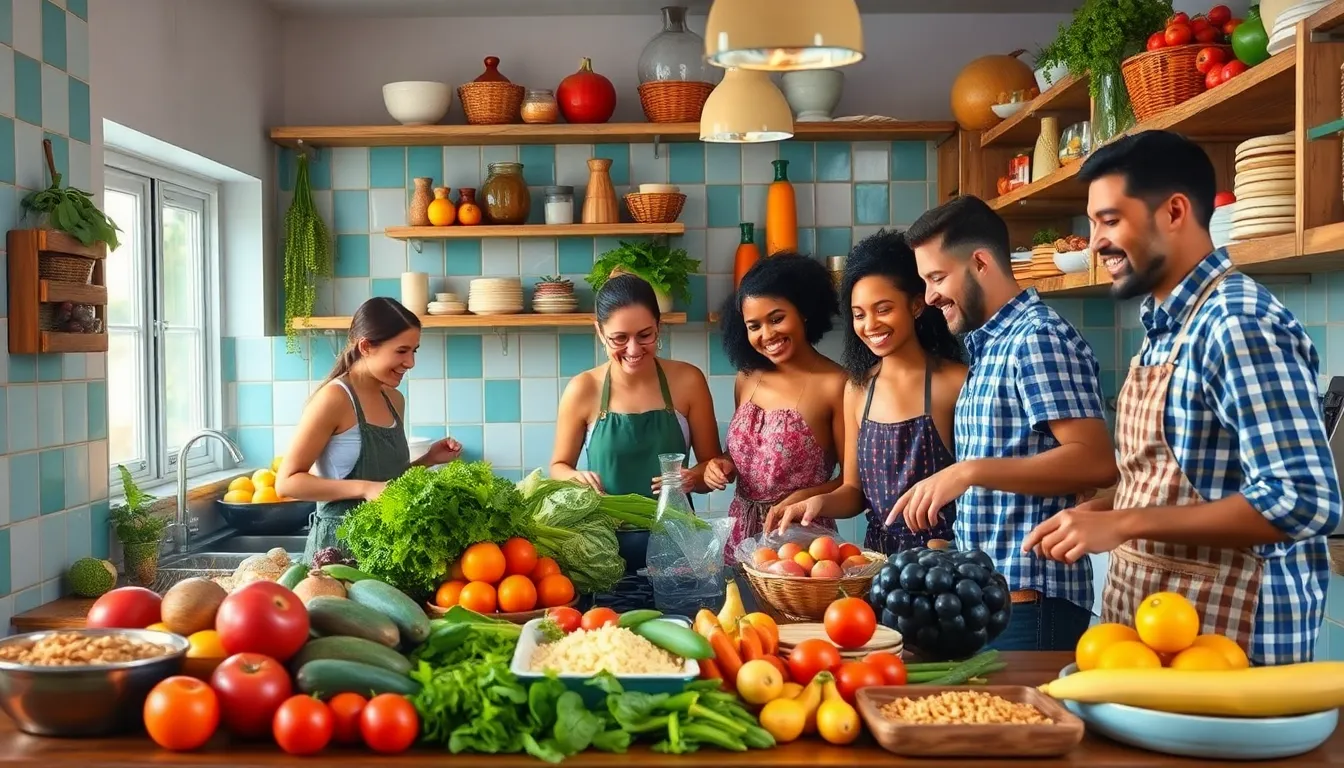In a world where kale reigns supreme and chickpeas are the new black, vegan recipes have taken the culinary stage by storm. Gone are the days of boring salads and bland tofu. Today’s plant-based dishes burst with flavor and creativity, making even the most devoted carnivores reconsider their dinner choices.
Table of Contents
ToggleOverview of Vegan Recipes
Vegan recipes encompass a wide range of dishes that prioritize plant-based ingredients. The variety offers something for every palate, from hearty stews to refreshing salads. Seasonal produce plays a crucial role in creating vibrant meals.
Innovative cooking techniques enable chefs to enhance flavors. Roasting vegetables brings out their natural sweetness, while marinating tofu adds depth. Grains like quinoa and farro serve as hearty bases, complementing diverse toppings and sauces.
Incorporating legumes such as chickpeas and lentils boosts protein content. These nutrient-dense ingredients contribute to satisfying meals, making them popular among various dietary preferences. Nuts and seeds often add crunch and flavor, enhancing texture in salads and desserts.
Experimenting with spices and herbs elevates dishes to new heights. Common spices, like cumin and paprika, create warmth, while fresh herbs like cilantro and basil provide freshness. This approach broadens the appeal beyond traditional expectations associated with vegan cuisine.
Desserts in vegan recipes also stand out for their uniqueness. Ingredients like coconut milk and aquafaba create rich textures without dairy. Plant-based sweeteners, such as maple syrup and agave nectar, offer natural alternatives to refined sugars.
Vegan recipes demonstrate versatility in meal preparation. From breakfast options, like smoothies and oatmeal bowls, to dinner favorites, like curry and stir-fry, the choices are endless. Chefs and home cooks continue to push the boundaries of what plant-based cooking can achieve.
Benefits of Vegan Cooking


Vegan cooking offers numerous advantages that extend beyond taste and creativity. It promotes health and supports environmental sustainability.
Health Advantages
Plant-based diets improve overall health well. Research indicates that diets rich in fruits, vegetables, and whole grains reduce the risk of chronic diseases. Vegan eating lowers cholesterol levels and blood pressure. Additionally, increased intake of fiber enhances digestive health. A plant-focused diet often leads to healthier weights since it typically contains fewer calories and more nutrients. Studies show that vegan meals can provide all necessary vitamins and minerals when balanced correctly, making it easier to maintain energy levels and a robust immune system.
Environmental Impact
Vegan cooking significantly reduces environmental footprints. Research highlights that plant-based diets consume fewer natural resources than meat-based diets. Raising animals for food contributes to greenhouse gas emissions, deforestation, and water pollution. In contrast, growing crops for direct human consumption demands less land and water. Switching to vegan recipes can lead to lower carbon emissions. It promotes biodiversity by reducing the need for resource-intensive animal agriculture. Embracing vegan choices supports a more sustainable planet for future generations.
Popular Vegan Ingredients
Vegan cooking features a variety of essential ingredients, each contributing to flavorful and nutritious meals. Understanding these components helps to elevate plant-based dishes.
Proteins and Legumes
Legumes play a crucial role in providing protein. Chickpeas, lentils, and black beans offer excellent sources for protein and fiber. Utilizing legumes in salads, stews, and burgers gives dishes heartiness. Tofu and tempeh also serve as popular meat substitutes. They absorb flavors well and can be marinated or seasoned to create delicious entrees. Edamame adds a protein boost as a snack or salad ingredient. Seitan, made from wheat gluten, mimics the texture of meat, making it a versatile choice for various recipes.
Grains and Seeds
Grains serve as the backbone of many vegan meals. Quinoa, brown rice, and farro provide complex carbohydrates and essential nutrients. Combining grains with vegetables or legumes creates satisfying bowls. Seeds, including chia, flax, and hemp, enhance both the nutritional profile and texture of dishes. Chia seeds, particularly, can be transformed into pudding or used as a thickener. Flaxseeds add a nutty flavor to smoothies and baked goods. Incorporating these grains and seeds makes meals more diverse and nutritious.
Fruits and Vegetables
Fruits and vegetables are the stars of vegan cooking. Seasonal produce enriches dishes with vibrant colors and flavors. Leafy greens like kale and spinach pack valuable vitamins, while root vegetables offer natural sweetness. Berries, mangoes, and citrus fruits add freshness and creativity to salads and desserts. Roasted or grilled vegetables enhance their natural flavors, making them perfect side dishes. Avocado spreads creamy richness in both savory and sweet recipes. Leveraging the variety of fruits and vegetables available results in exciting meal options.
Easy Vegan Recipes to Try
Exploring simple vegan recipes offers delicious ways to enjoy plant-based meals. Below are several ideas spanning breakfast, lunch, and dinner.
Breakfast Ideas
Start the day with smoothies that blend spinach, banana, and almond milk for a nutrient boost. Overnight oats made with coconut milk, chia seeds, and berries provide a hearty and satisfying option. Try avocado toast topped with cherry tomatoes and sesame seeds for a quick yet flavorful meal. Breakfast burritos can incorporate black beans, roasted peppers, and nutritional yeast wrapped in a whole grain tortilla. These easy ideas highlight how breakfast can be both energizing and vibrant.
Lunch Options
Chickpea salads can combine diced cucumber, bell peppers, and lemon vinaigrette, creating a refreshing lunch choice. Quinoa bowls offer endless possibilities by mixing roasted sweet potatoes, kale, and tahini dressing. Hummus sandwiches made with whole grain bread, spinach, and sliced radishes present another satisfying alternative. Grain salads maintain vibrancy with added fruits like apples or oranges. Each lunch option emphasizes the diverse flavors achievable with simple, plant-based ingredients.
Dinner Delights
Stir-fries can feature tofu, broccoli, and snap peas tossed in a savory soy sauce. Hearty lentil soups mix carrots, celery, and spices, providing warmth on cooler evenings. Spaghetti made from zucchini noodles and served with marinara sauce showcases a low-carb meal packed with vegetables. Curries can blend chickpeas, coconut milk, and spinach, offering a creamy and satisfying dish. These dinner delights demonstrate the creativity possible within vegan cooking.




